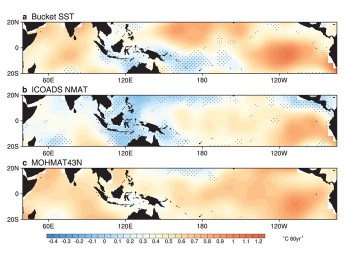Changes in Sea Surface Temperature Patterns Caused 60-Year Slowdown of Walker Circulation
November 14, 2012

Scientists have discovered the cause for an observed slowdown in the Walker Circulation (WC) over the past 60 years, and in the process boosted their confidence in atmospheric models.
The WC is a wind pattern in the tropical Pacific that, as it changes from year to year, spawns floods and droughts in North America and other regions of the world. Meteorological observations over the last 60 years show this atmospheric circulation has slowed down: the trade winds have weakened and rainfall has shifted eastward toward the central Pacific. Until now, most experts attributed the slowdown to a muted hydrological cycle, which in turn was driven by global warming. But, according to a new study published in this week’s edition of the journal Nature, the WC slowdown was instead due to changes in sea surface temperature (SST) patterns across the tropical Pacific.
The team, led by Hiroki Tokinaga, assistant researcher at the University of Hawaii at Manoa’s International Pacific Research Center, constructed a 60-year history of SSTs in the tropical Pacific based on two sources: water temperatures measured in bucket samples collected from ships and nighttime marine surface air temperatures measured from ships and buoys. The team found that, even though SSTs rose along with the rest of the planet, the average temperature difference between the eastern Pacific and the western Pacific/southeastern Indian Ocean decreased over the last 60 years. In other words, SST patterns in the tropical Pacific Ocean have slowly shifted to a more El Niño-like state.
Until recently, atmospheric models did a poor job reproducing the WC slowdown, which cast doubt on their ability to accurately forecast future climate. Using the new SST reconstruction in three widely used atmospheric models, the scientists were able to accurately reproduce the WC slowdown, boosting their confidence in the models.
Yuko Okumura, research associate in the University of Texas at Austin’s Institute for Geophysics, ran one series of simulations using an atmospheric model at the National Center for Atmospheric Research in Boulder, CO.
“As Earth warms, sea surface temperatures do not warm at the same rate everywhere,” says Okumura. “We found that the differences in warming across the tropics are very important in driving atmospheric circulation. This means oceanic and atmospheric circulation are very tightly coupled.”
“Our experiments show that the main driver of the change in the Walker circulation is the gradual change that has taken place in the surface temperature pattern toward a more El Niño-like state,” explains Tokinaga. “We don’t have enough data yet to say to what degree the trend over the last 60 years is due to a rise in man-made greenhouse gasses or to natural cycles in the climate.”
“Short-term fluctuations in the strength of the Walker circulation happen every few years: during La Niña the circulation strengthens, during El Niño it weakens,” says co-author Shang-Ping Xie, meteorology professor at the International Pacific Research Center. “The Walker circulation affects tropical convection, and the global impacts of a temporary slowdown during an El Niño are well known, resulting in extreme floods or droughts in North America and other regions of the world. What impact the gradual slowdown we observe in this study has on global climate still needs to be investigated.”
